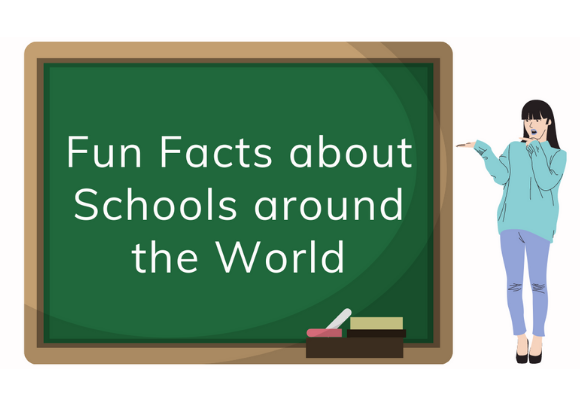18 Fun Facts About Schools Around The World
 Schooladvisor Team
Schooladvisor TeamHow much do you really know about schools around the world apart from different curriculums? There is a whole lot more beyond the books and buildings that you probably don't know of. Here are some interesting facts about schools from around the world that might blow your mind:
1. A primary school in Phuma Changthang, Tibet, is thought to be the highest school in the world.

It is also the closest of its kind to the sky. At 5,373 metres above sea level, it is 200 metres higher than the base camp of Mount Qomolangma, the world’s highest mountain, known as Mount Everest in the West.
2. The Shishi High School located in Chengdu, China is the world's oldest school.

Established in 194 AD, earning the title of being the world's oldest school comes with no surprise. The first Chinese public school to ever exist, the school became a modern school in 1902. Despite its age, the school is up-to-date with quality equipment and supplies and provides modern education.
3. A school in the Philippines is made entirely of recycled pop bottles.

The school named Bottle School is one of its kind in Asia. It took about 9,000 bottles and dozens of volunteers to build the structure. Each bottle was filled with sand, water and straw to keep them sturdy. Then, a cement-like substance was used to hold the bottles in place as they were stacked on top of each other to create walls.
4. The largest school in the world in terms of number of students is the City Montessori School in Lucknow, India.

The City Montessori School (CMS) in India enters the 2019 Guinness Book of World Records for its number of pupils attending the school. There are currently more than 56,000 students attending the school on a daily basis. In Lucknow city alone, there are 18 CMS campuses with over 4,500 staff across the city.
5. Back in 2014, there was an elementary school in Turin, Italy that only had one teacher and one student.

This gives the school the reputation of being the smallest school in the world. The only student of the school admitted to being lonely and had to imagine there were other students in the classroom. Officials decided to keep it open as long as there is at least one pupil at the school.
6. The children in the Netherlands start school on their fourth birthday so there’s always someone new in class.

While this means that older students get more time to settle in and make friends, it does also mean that students should be at a similar development level by the time their first day at school rolls around.
7. Meal-time in France is considered part of the curriculum.

Although kids generally learn eating and tasting food at home, these skills are reinforced in schools. Kids are expected to learn not only about different foods and where they come from (schools try to source locally), but also to display good manners and etiquette.
8. Students in South Korea are expected to stay and help clean and tidy the classroom when lessons are over.

The tasks include sweeping, vacuuming and taking out the trash. No running out of class the second lessons are over for Korean students!
9. Kids in Finland do not start school until the age of 7.
Seven is considered one of the oldest ages around the world to start school. Most do, however, attend high-quality daycare or preschool programmes.
10. In Russia, children always start school on ‘Knowledge Day’ (September 1) even if it’s a weekend or a holiday.

The morning usually starts with a school assembly during which 11th-graders (the oldest students) take the first-graders by the hand and lead them into the school while ringing a ceremonial bell.
11. Have you ever seen a boat school? In Bangladesh, there are no fewer than 100 boat schools!

In Bangladesh, annual flooding can disrupt school for hundreds of thousands of students. In some areas, roads are impassable during the rainy season from July to October, when rivers rise as much as four metres, or 12 feet; hence, the need for boat schools. Each one of the boat schools has internet access, a library and is solar powered.
12. In a remote area of Colombia, kids have to travel to school on a zip-line.

It turns out the steel wires are the only form of transportation for those living in an isolated valley called Los Pinos. Very young kids are not allowed to use the zip-line alone. So they travel along the cable with their parents or an older sibling. If the kids did not travel this way, they would have to walk through the rainforest and it would take two hours to get to school.
13. A school in Germany has been built to look like a giant white cat.

The design is complete with whiskers and circular windows for eyes. When students arrive at the school, they enter the building through the mouth of the cat. Once inside, it is just like any other school. But there is at least one more purr-fect feature that students can enjoy: the cat’s tail found at the back of the building doubles as a slide!
14. Summer vacations in Chile start from mid-December and end in early March.

While schools in the United States normally start summer vacation between May and June, Chile begins their summer holiday in December with three whole months away from school!
15. Children in Germany receive special paper cones called Schultüte when they begin school.
Traditionally, the cones are filled with sweets and candy. At present, children will find sweets alongside school supplies and toys in their paper cones. But the catch is that they can only open it when they start school. The cone tradition is a celebration to indicate that the child is moving to the next stage of their lives.
16. Kids in Japan are the most independent and disciplined of the lot.
They travel to school alone, clean their own classrooms and even serve their own lunch. There are no janitors or canteens in the schools. On special occasions, students are allowed to bring their own lunch boxes, however, for most days, they will eat the same meal with each other.
17. It is not mandatory to attend a pre-primary or early childhood development and education class before joining primary school for children in Kenya.

But they mostly go anyway! The lack of early childhood education among African children is a hot debate but that is a story for another time.
18. France has the shortest school year from August to June and also the longest school day.

A total school year in France does not exceed 36 weeks while other countries may go over 40 weeks. French children go to school four days a week with off days on Wednesday, Saturday and Sunday. They have about two hours each day for lunch and their school day begins around 8:30 a.m. and ends at 4:30 p.m.
Recent Articles
- The Heart of an International School Is Homegrown
- Meet the Visionaries: Rami Madani, Head of School at ISKL, on His Vision for Meaningful Education
- The British vs. American vs. Australian Curriculum: Which is Right for Your Child?
- IB VS IGCSE: Which One is Right for Your Child?
- How to Choose the Right International School in Malaysia: A Guide for Parents




